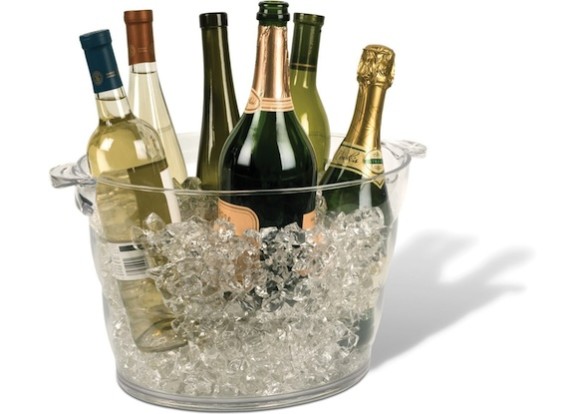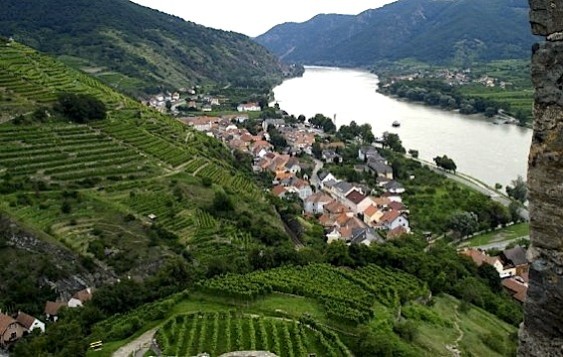Though we’re a few weeks into fall and temperatures are (finally) starting to dip in parts of the country, in LA where I’m based, we’re still almost in the triple digits. I don’t even want to think about drinking red wine at the moment, and for the rest of you Californians in the same sweltering boat as me, I wanted to give you some suggestions of interesting white wines that will keep you cool this weekend.
Forget those oaky Chardonnays and grassy Sauvignon Blancs. Here are three other offbeat white varieties I’ve come across in my travels to whet your whistle while discovering something new.

Keep cool with these wines this weekend. Photo source: Oempromo.
Torrontés
Pronounced tore-rone-TESS, this is Argentina’s flagship white wine, and is produced mainly in the northern desert region of Salta around the town of Cafayate. The landscape there is incredible with red rock formations that remind me of the Sonoran desert around Sedona in Arizona.
The area has been growing wine for a couple centuries now, and though its production pales in comparison to that of its flashier compatriot, Mendoza, the wines from here are well worth checking out. The Malbecs tend to be a bit spicier with more peppery notes to them than those of Mendoza.

The high-desert landscape around Cafayate reminds me of Sedona.
But the real star here is Torrontés. If it were a male movie star, it would be Matthew McConaughey – easygoing but with a certain underlying, sunny energy. The wines this grape produces are very aromatic with heady perfumes of white flowers, lovely citrus notes of things like grapefruit as well as stone fruits like peach, and some very slight green flavors like fresh-cut grass. Torrontés tends to be lighter-bodied than Chardonnay and not so mouth-puckeringly crisp as Sauvignon Blanc. In short, it’s the perfect on-its-own easy-drinking wine for a scorching afternoon. Here’s one to try.
2013 Dominio Del Plato “Crios de Susana” Balbo Torrontes: This Torrontés is an interesting one because it is actually a blend of grapes from Mendoza’s Uco Valley as well as Cafayate, so it’s good survey of Argentina’s wine regions in one bottle. It displays hallmark tropical aromas of pineapple, green lime, and some spicy white peppery notes as well with a crisp finish. Best of all, it’s only $11.99.
Grüner Veltliner
This white variety from Austria has been cropping up on more and more wine lists lately, and to be in the know, you should pronounce it GREW-nur velt-LEEN-er. I personally love it because it’s so agile but versatile and pairs with a variety of foods. If we’re sticking with male movie stars, this one is more like Tom Hardy – sharp, clear, focused energy, tightly wound and explosive in all the right ways.
I usually find the dominant flavors in Grüner Veltliner to be lime, grapefruit and apricot on the fruity side of the spectrum, and herbaceous notes like ginger and tarragon, with minerally notes of limestone and granite plus a sky-high acidity that make it bone-dry but mouthwatering.

Many of Austria’s best Grüners come from the scenic Wachau region along the Danube.
Though there are tons of Grüners worthy of your time and attention, if you only have a chance to try one this weekend, think about this one.
2013 Nikolaihof “Hefeabzug” Grüner Veltliner: This biodynamic winery is one of the best-known wine producers in Austria, and one of my favorites. Though priced at $26.99, I’d still say this one is a relative bargain. It’s both light and refreshing with flavors of melon and papaya, it also contains interesting nuances of mineral tanginess and even a slightly smoky characteristic that makes it even more intriguing. Try it with some sushi or spicy Asian food.
Friulano
Once known as Tocai Friulano (but no longer due to naming rights legal battles among a few European regions), this grape hails from the northeast of Italy, where it is especially popular in Friuli and Collio.
The grape is actually a relative of Sauvignon Blanc and is known in other places as either Sauvignonasse (not my favorite name) and Sauvignon Vert (mostly in Chile). However, it tends to be more full-bodied than Sauvignon Blanc, with a little more elegance and finesse, and with fewer green-tasting notes to it.
For me, it’s kind of like the Ryan Gosling of white wine. Soft-spoken but with an undercurrent of intensity that surfaces every so often. I tend to find bright citrusy accents of lemon and even tangerine, as well as green apple or pear, some nutty notes, and an overarching acid structure that keeps it tasting fresh to the last drop.
2013 Tocai Friulano, Honea Vineyard, Palmina Wines: One of my favorite versions of this wine actually comes from this winery up in Lompoc, in Santa Barbara County. You can usually find it at your local Whole Foods, and it’s priced at around $20-$24. Palmina’s iteration displays that characteristic pale gold color, and initial bursts of fresh lemon on the palate with more filigreed notes of white flowers and a lingering finish reminiscent of fresh marzipan. Have it with grilled vegetables or light fish dishes.
What are you drinking this weekend? Tweet me @clustercrush and let me know!

